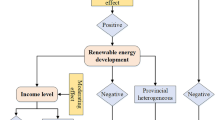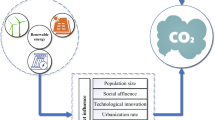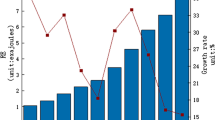Abstract
There has always been controversy over how renewable energy technologies can play a role in reducing carbon emissions. Based on the energy patent data and the economic data of 244 prefecture-level cities from 2007 to 2017 in China, we explore the carbon reduction effect of renewable energy technology and its mechanism from the perspective of energy production, conservation, and management. The two-way fixed effect, instrumental variable, spatial Durbin, and mediation effect models are employed to explore empirical results. We found that (1) the impact of renewable energy technologies on carbon emissions is nonlinear, with an inverted U shape. However, this inverted U-shaped relationship only exists locally in cities and there are uncertainties in adjacent cities, which indicates that cross-regional cooperation in renewable energy technology needs to be improved. (2) The mechanism analysis shows that industrial agglomeration and energy consumption scale are the channels that renewable energy technologies affect carbon emissions. Thus, the implicit carbon emissions generated by industrial agglomeration and the failure to green upgrade energy consumption are the main reasons for the inverted U-shaped relationship. (3) The carbon reduction effect of renewable energy technologies of conservation type takes effect first, and renewable energy technologies of production type do not reduce carbon emissions in non-eastern cities, which means that non-eastern cities are likely to become pollution havens. This study provides evidence for renewable energy technologies to achieve efficient carbon emission reduction and cross-regional technical cooperation.


Similar content being viewed by others
References
Acheampong AO, Amponsah M, Boateng E (2020) Does financial development mitigate carbon emissions? Evidence from heterogeneous financial economies. Energy Econ 88:104768. https://doi.org/10.1016/j.eneco.2020.104768
Álvarez-herránz A, Balsalobre D, María J, Shahbaz M (2017) Energy innovations-GHG emissions nexus: fresh empirical evidence from OECD countries. Energy Policy 101:90–100. https://doi.org/10.1016/j.enpol.2016.11.030
Balado-Naves R, Baños-Pino JF, Mayor M (2018) Do countries influence neighbouring pollution? A spatial analysis of the EKC for CO2 emissions. Energy Policy 123:266–279. https://doi.org/10.1016/j.enpol.2018.08.059
Berner A, Bruns S, Moneta A, Stern DI (2022) Do energy efficiency improvements reduce energy use? Empirical evidence on the economy-wide rebound effect in Europe and the United States. Energy Econ. 110:105939. https://doi.org/10.1016/j.eneco.2022.105939
Chang JJ, Wang WN, Shieh JY (2018) Environmental rebounds/backfires: macroeconomic implications for the promotion of environmentally-friendly products. J. Environ. Econ. Manage 88:35–68. https://doi.org/10.1016/j.jeem.2017.09.004
Chen J, Wang P, Cui L, Huang S, Song M (2018a) Decomposition and decoupling analysis of CO2 emissions in OECD. Appl. Energy 231:937–950. https://doi.org/10.1016/j.apenergy.2018.09.179
Chen Z, Kahn ME, Liu Y, Wang Z (2018b) The consequences of spatially differentiated water pollution regulation in China. J Environ Econ Manage 88:468–485. https://doi.org/10.1016/j.jeem.2018.01.010
Chen X, Chen YE, Chang CP (2019) The effects of environmental regulation and industrial structure on carbon dioxide emission: a non-linear investigation. Environ. Sci. Pollut. Res 26:30252–30267. https://doi.org/10.1007/s11356-019-06150-6
Chen J, Gao M, Cheng S, Liu X, Hou W, Song M, Li D, Fan W (2021) China’s city-level carbon emissions during 1992–2017 based on the inter-calibration of nighttime light data. Sci. Rep 11:1–13. https://doi.org/10.1038/s41598-021-81754-y
Chen X, Xu H, Zhang L, Cao H (2022a) Spatial functional division, infrastructure and carbon emissions: evidence from China. Energy 256:124551. https://doi.org/10.1016/j.energy.2022.124551
Chen Y, Yao Z, Zhong K (2022b) Do environmental regulations of carbon emissions and air pollution foster green technology innovation: evidence from China’s prefecture-level cities. J Clean Prod 350:131537. https://doi.org/10.1016/j.jclepro.2022.131537
Chen Y, Zhu Z, Cheng S (2022c) Industrial agglomeration and haze pollution: evidence from China. Sci Total Environ 845:157392. https://doi.org/10.1016/j.scitotenv.2022.157392
Dauda L, Long X, Mensah CN, Salman M, Boamah KB, Ampon-Wireko S, Kofi Dogbe CS (2021) Innovation, trade openness and CO2 emissions in selected countries in Africa. J Clean Prod 281:125143. https://doi.org/10.1016/j.jclepro.2020.125143
Dilanchiev A, Nuta F, Khan I, Khan H (2023) Urbanization, renewable energy production, and carbon dioxide emission in BSEC member states: implications for climate change mitigation and energy markets. Environ Sci Pollut Res 30(25):67338–67350. https://doi.org/10.1007/s11356-023-27221-9
Dong F, Zhu J, Li Y et al (2022) How green technology innovation affects carbon emission efficiency: evidence from developed countries proposing carbon neutrality targets. Environ Sci Pollut Res 29:35780–35799. https://doi.org/10.1007/s11356-022-18581-9
Du Y, Li Z, Du J, Li N, Yan B (2019) Public environmental appeal and innovation of heavy-polluting enterprises. J Clean Prod 222:1009–1022. https://doi.org/10.1016/j.jclepro.2019.03.035
Fernández AM, Ferrándiz E, Medina J (2022) The diffusion of energy technologies. Evidence from renewable, fossil, and nuclear energy patents. Technol Forecast Soc Change 178:121566. https://doi.org/10.1016/j.techfore.2022.121566
Habiba U, Xinbang C, Anwar A (2022) Do green technology innovations, financial development, and renewable energy use help to curb carbon emissions? Renew. Energy 193:1082–1093. https://doi.org/10.1016/j.renene.2022.05.084
Hu T, Wang T, Yan Q, Chen T, Jin S, Hu J (2022) Modeling the spatiotemporal dynamics of global electric power consumption (1992–2019) by utilizing consistent nighttime light data from DMSP-OLS and NPP-VIIRS. Appl Energy 322:119473. https://doi.org/10.1016/j.apenergy.2022.119473
Huang J, Li X, Wang Y, Lei H (2021) The effect of energy patents on China’s carbon emissions: evidence from the STIRPAT model. Technol Forecast Soc Change 173:121110. https://doi.org/10.1016/j.techfore.2021.121110
Jiang W, Cole M, Sun J, Wang S (2022) Innovation, carbon emissions and the pollution haven hypothesis: climate capitalism and global re-interpretations. J Environ Manage 307:114465. https://doi.org/10.1016/j.jenvman.2022.114465
Jo HK (2002) Impacts of urban greenspace on offsetting carbon emissions for middle Korea. J Environ Manage 64:115–126. https://doi.org/10.1006/jema.2001.0491
Johnstone N, Hascic I, Popp D (2010) Renewable energy policies and technological innovation: evidence based on patent counts. Environ Resour Econ 45:133–155. https://doi.org/10.1007/s10640-009-9309-1
Kahn ME, Kotchen MJ (2011) Business cycle effects on concern about climate change: the chilling effect of recession. Clim Chang Econ 2:257–273. https://doi.org/10.1142/S2010007811000292
Khan H, Weili L, Khan I, Zhang J (2023a) The nexus between natural resources, renewable energy consumption, economic growth, and carbon dioxide emission in BRI countries. Environ Sci Pollut Res 30:36692–36709. https://doi.org/10.1007/s11356-022-24193-0
Khan H, Weili L, Khan I, Zhang J (2023b) Exploring the nexus between energy consumption, income inequality and poverty, economic growth, and carbon dioxide emission: evidence from two step system generalized method of moments. Environ Sci Pollut Res 30:35996–36011. https://doi.org/10.1007/s11356-022-24695-x
Li W, Yang G, Li X (2021) Correlation between PM2.5 pollution and its public concern in China: evidence from Baidu Index. J Clean Prod 293:81–109. https://doi.org/10.1016/j.jclepro.2021.126091
Lin B, Ma R (2022) Green technology innovations, urban innovation environment and CO2 emission reduction in China: fresh evidence from a partially linear functional-coefficient panel model. Technol Forecast Soc Change 176:121434. https://doi.org/10.1016/j.techfore.2021.121434
Lin B, Zhu J (2019) The role of renewable energy technological innovation on climate change: empirical evidence from China. Sci Total Environ 659:1505–1512. https://doi.org/10.1016/j.scitotenv.2018.12.449
Liu Z, He C, Zhang Q, Huang Q, Yang Y (2012) Extracting the dynamics of urban expansion in China using DMSP-OLS nighttime light data from 1992 to 2008. Landsc Urban Plan 106:62–72. https://doi.org/10.1016/j.landurbplan.2012.02.013
Liu X, Ji X, Zhang D, Yang J, Wang Y (2019) How public environmental concern affects the sustainable development of Chinese cities: an empirical study using extended DEA models. J Environ Manage 251:109619. https://doi.org/10.1016/j.jenvman.2019.109619
Noailly J, Shestalova V (2017) Knowledge spillovers from renewable energy technologies: lessons from patent citations. Environ Innov Soc Transitions 22:1–14. https://doi.org/10.1016/j.eist.2016.07.004
Noailly J, Smeets R (2015) Directing technical change from fossil-fuel to renewable energy innovation: an application using firm-level. J Environ Econ Manage 72:15–37. https://doi.org/10.1016/j.jeem.2015.03.004
Noailly J, Smeets R (2021) Financing energy innovation: internal finance and the direction of technical change. Environ Resour Econ 83:145–169. https://doi.org/10.1007/s10640-021-00602-9
O’Donoghue D, Gleave B (2004) A note on methods for measuring industrial agglomeration. Reg Stud 38:419–427. https://doi.org/10.1080/03434002000213932
Obobisa ES, Chen H, Mensah IA (2022) The impact of green technological innovation and institutional quality on CO2 emissions in African countries. Technol Forecast Soc Change 180:121670. https://doi.org/10.1016/j.techfore.2022.121670
Peng W, Yin Y, Kuang C, Wen Z, Kuang J (2021) Spatial spillover effect of green innovation on economic development quality in China: evidence from a panel data of 270 prefecture-level and above cities. Sustain Cities Soc 69:102863. https://doi.org/10.1016/j.scs.2021.102863
Qu F, Xu L, Zheng B (2022) Directed technical change and pollution emission: evidence from fossil and renewable energy technologies in China. Front Energy Res 10:1–11. https://doi.org/10.3389/fenrg.2022.794104
Qu F, Xu L, He C (2023) Leverage effect or crowding out effect? Evidence from low-carbon city pilot and energy technology innovation in China. Sustain Cities Soc 91:104423. https://doi.org/10.1016/j.scs.2023.104423
Sadorsky P (2014) The effect of urbanization on CO2 emissions in emerging economies. Energy Econ 41:147–153. https://doi.org/10.1016/j.eneco.2013.11.007
Shahbaz M, Destek MA, Dong K, Jiao Z (2021) Time-varying impact of financial development on carbon emissions in G-7 countries: evidence from the long history. Technol Forecast Soc Change 171:120966. https://doi.org/10.1016/j.techfore.2021.120966
Shao S, Yang L, Yu M, Yu M (2011) Estimation, characteristics, and determinants of energy-related industrial CO2 emissions in Shanghai (China), 1994–2009. Energy Policy 39:6476–6494. https://doi.org/10.1016/j.enpol.2011.07.049
Shao S, Hu Z, Cao J, Yang L, Guan D (2020) Environmental regulation and enterprise innovation: a review. Bus Strateg Environ 29:1465–1478. https://doi.org/10.1002/bse.2446
Su Y, Fan Q m (2022) Renewable energy technology innovation, industrial structure upgrading and green development from the perspective of China’s provinces. Technol Forecast Soc Change 180:121727. https://doi.org/10.1016/j.techfore.2022.121727
Sufyanullah K, Ahmad KA, Sufyan Ali MA (2022) Does emission of carbon dioxide is impacted by urbanization? An empirical study of urbanization, energy consumption, economic growth and carbon emissions - using ARDL bound testing approach. Energy Policy 164:112908. https://doi.org/10.1016/j.enpol.2022.112908
Sun H, Edziah BK, Sun C, Kporsu AK (2019) Institutional quality, green innovation and energy efficiency. Energy Policy 135:111002. https://doi.org/10.1016/j.enpol.2019.111002
Wahab S (2021) Does technological innovation limit trade-adjusted carbon emissions? Environ Sci Pollut Res 28:38043–38053. https://doi.org/10.1007/s11356-021-13345-3
Wang Z, Zhu Y (2020) Do energy technology innovations contribute to CO2 emissions abatement? A spatial perspective Sci Total Environ 726:138574. https://doi.org/10.1016/j.scitotenv.2020.138574
Wang Z, Zhang B, Liu T (2016) Empirical analysis on the factors influencing national and regional carbon intensity in China. Renew Sustain Energy Rev 55:34–42. https://doi.org/10.1016/j.rser.2015.10.077
Wang WZ, Liu LC, Liao H, Wei YM (2021a) Impacts of urbanization on carbon emissions: an empirical analysis from OECD countries. Energy Policy 151(7):112171. https://doi.org/10.1016/j.enpol.2021.112171
Wang KL, Zhao B, Ding LL, Miao Z (2021b) Government intervention, market development, and pollution emission efficiency: evidence from China. Sci Total Environ 757:143738. https://doi.org/10.1016/j.scitotenv.2020.143738
Wang X, Fan LW, Zhang H (2023) Policies for enhancing patent quality: evidence from renewable energy technology in China. Energy Policy 180:113660. https://doi.org/10.1016/j.enpol.2023.113660
Xie R, Fang J, Liu C (2017) The effects of transportation infrastructure on urban carbon emissions. Appl Energy 196:199–207. https://doi.org/10.1016/j.apenergy.2017.01.020
Xu B, Lin B (2015) How industrialization and urbanization process impacts on CO2 emissions in China: evidence from nonparametric additive regression models. Energy Econ 48:188–202. https://doi.org/10.1016/j.eneco.2015.01.005
Xu L, Fan M, Yang L, Shao S (2021) Heterogeneous green innovations and carbon emission performance: evidence at China’s city level. Energy Econ 99:105269. https://doi.org/10.1016/j.eneco.2021.105269
Yang L, Li Z (2017) Technology advance and the carbon dioxide emission in China – empirical research based on the rebound effect. Energy Policy 101:150–161. https://doi.org/10.1016/j.enpol.2016.11.020
Yang F, Cheng Y, Yao X (2019) Influencing factors of energy technical innovation in China: evidence from fossil energy and renewable energy. J Clean Prod 232:57–66. https://doi.org/10.1016/j.jclepro.2019.05.270
Yang G, Zha D, Zhang C, Chen Q (2020) Does environment-biased technological progress reduce CO2 emissions in APEC economies? Evidence from fossil and clean energy consumption. Environ Sci Pollut Res 27:20984–20999. https://doi.org/10.1007/s11356-020-08437-5
Zhang XP, Cheng XM (2009) Energy consumption, carbon emissions, and economic growth in China. Ecol Econ 68:2706–2712. https://doi.org/10.1016/j.ecolecon.2009.05.011
Zhang C, Zhou X (2016) Does foreign direct investment lead to lower CO2 emissions? Evidence from a regional analysis in China. Renew Sustain Energy Rev 58:943–951. https://doi.org/10.1016/j.rser.2015.12.226
Zhao M, Kong Z, Escobedo FJ, Gao J (2010) Impacts of urban forests on offsetting carbon emissions from industrial energy use in Hangzhou. China J Environ Manage 91:807–813. https://doi.org/10.1016/j.jenvman.2009.10.010
Zheng S, Wu J, Kahn ME, Deng Y (2012) The nascent market for “green” real estate in Beijing. Eur Econ Rev 56:974–984. https://doi.org/10.1016/j.euroecorev.2012.02.012
Zhu Y, Wang Z, Yang J, Zhu L (2020) Does renewable energy technological innovation control China’s air pollution? A spatial analysis J Clean Prod 250:119515. https://doi.org/10.1016/j.jclepro.2019.119515
Acknowledgements
The authors wish to gratefully acknowledge the editors and reviewers for their insightful and helpful comments that improved the manuscript.
Funding
This work was supported by the Open Fund of Sichuan Oil and Gas Development Research Center (SKB23-06) and the Institute for Healthy Cities of Chengdu (2023ZC06).
Author information
Authors and Affiliations
Contributions
Fang Qu: conceptualization, writing, collecting data, methodology, revision, and proofreading. Chun-Mei Li: revision and proofreading.
Corresponding author
Ethics declarations
Ethical approval
N/A
Consent to participate
N/A
Consent for publication
N/A
Competing interests
The authors declare no competing interests.
Additional information
Responsible Editor: V.V.S.S. Sarma
Publisher’s note
Springer Nature remains neutral with regard to jurisdictional claims in published maps and institutional affiliations.
Appendices
Appendix 1
Table 17 is a supplement to Table 2, where population density (lnPOP), transportation infrastructure (lnTI), government intervention (lnGOV), and urbanization (lnURB) have positive impacts on carbon emissions (Huang et al. 2021; Zhang and Cheng 2009). The main reason why government regulation increases carbon emissions is its one-size-fits-all intervention. The first term of economic development (lnpGDP) is positive, while the second term (lnpGDP2) is negative, which is consistent with the assumption of the environmental Kuznets curve (EKC). This implies that there is an inverted U-shaped relationship between economic development and pollution emissions (Chen et al. 2022c), where initially pollution increases with economic development but eventually decreases. Finally, the impact of green space (lnGS), foreign direct investment (lnFDI), and financial development (lnFD) on carbon emissions is uncertain.
Appendix 2
Rights and permissions
Springer Nature or its licensor (e.g. a society or other partner) holds exclusive rights to this article under a publishing agreement with the author(s) or other rightsholder(s); author self-archiving of the accepted manuscript version of this article is solely governed by the terms of such publishing agreement and applicable law.
About this article
Cite this article
Qu, ., Li, CM. Carbon emission reduction effect of renewable energy technology innovation: a nonlinear investigation from China’s city level. Environ Sci Pollut Res 30, 98314–98337 (2023). https://doi.org/10.1007/s11356-023-29245-7
Received:
Accepted:
Published:
Issue Date:
DOI: https://doi.org/10.1007/s11356-023-29245-7




